Abstract
The Medina of Fez, a UNESCO World Heritage Site, is a cultural and historical treasure requiring innovative approaches for its preservation and promotion in the digital era. This paper presents MedinaOnto, an ontology dedicated to modeling the built cultural heritage of the Medina of Fez, developed in alignment with established standards like CIDOC-CRM, FOAF, and GEOSPARQL. The ontology aims to structure and interconnect knowledge about the Medina’s buildings while integrating social, geospatial, and historical dimensions. Based on the Core Data Standard and enriched with structured data from open sources such as Wikidata and DBpedia, the ontology aims to represent a wide range of heritage entities, including monuments, historic buildings, and culturally significant spaces. The modeling approach followed a structured ontology engineering methodology, combining domain analysis, concept extraction, the formulation of Competency Questions, and iterative refinement. The evaluation of the ontology was conducted through logical consistency tests, scenario-based validation, and SPARQL queries derived from Competency Questions. The results confirmed that MedinaOnto enables robust semantic reasoning and effective data querying. Designed as a reusable and scalable semantic framework, Medina Onto targets both public and heritage professionals, with a focus on valorization, mediation, and research.
Keywords:
ontology; cultural heritage; ontology mapping; medina of Fez; CIDOC-CRM; GEOSPARQL; core data standard; FOAF 1. Introduction
Founded in the 9th century, the Medina of Fez is an invaluable treasure of Moroccan and global cultural heritage. Recognized as a UNESCO World Heritage site [1], it holds exceptional historical significance as one of the oldest continuously inhabited Islamic cities. Its iconic landmarks, including Al Quaraouiyine University, palaces, mosques, and madrasas, showcase the evolution of Islamic architecture and highlight Fez’s role as an intellectual and spiritual center.
To ensure the preservation of these historical structures and facilitate their study, the use of modern modeling tools is essential. These tools enable efficient management and integration of the various dimensions of this historic city. A recent comparative study of cultural heritage ontologies [2] has highlighted CIDOC-CRM1 as a leading and widely adopted framework for representing heritage information, due to its comprehensive structure and semantic richness. The combined use of CIDOC-CRM, GEOSPARQL2, and FOAF3 ontologies plays a crucial role in this process, providing a structured approach to heritage documentation by incorporating both geographical and social information while ensuring interoperability with international standards.
This study aims to model the historical entities of the medina of Fez using these three ontologies. CIDOC-CRM offers a standardized framework for cultural heritage documentation, GEOSPARQL structures geographic data, and FOAF represents the people and communities associated with this heritage. This approach not only enhances knowledge preservation but also promotes data sharing within the international community, contributing to more effective heritage management in Fez.
Based on the Core Data Standard4 and enriched with structured data from open sources such as Wikidata and DBpedia, the proposed MedinaOnto ontology aims to provide a formal, extensible, and interoperable representation of a wide range of heritage entities. It specifically covers monuments, historic buildings, and urban spaces of high cultural value, particularly within the context of the Medina of Fez, a UNESCO World Heritage site.
The main motivation for this work stems from the growing need for structured knowledge models. These models must effectively represent the complexity of urban heritage environments, particularly in cases such as the Medina of Fez. Here, architectural elements, spatial entities, and historical actors all interact within a dense urban fabric rich in history.
Traditional documentation systems struggle to capture the full spectrum of semantic relationships between places, functions, events, and actors. MedinaOnto aims to bridge this gap by providing a formal knowledge base. This base is designed to be versatile, supporting various uses such as scientific research, cultural mediation, interactive exploration, and heritage information systems. This research seeks to answer the following core questions:
- RQ1: How can a coherent and extensible ontological structure be defined to model the diverse, built heritage of the Medina of Fez, explicitly integrating its historical, spatial, architectural, socio-cultural, and heritage management dimensions?
- RQ2: To what extent can this ontology be aligned with established Semantic Web standards (CIDOC-CRM, GEOSPARQL, FOAF) to ensure semantic interoperability and facilitate the explicit representation of heritage values?
- RQ3: “How can MedinaOnto help heritage professionals quickly access essential information about the condition and socio-cultural value of monuments to support their preservation and enhancement decisions better, while improving cultural mediation for the general public?”
The remainder of the paper is structured as follows: Section 2 reviews existing work on cultural heritage ontologies. Section 3 provides a detailed account of the MedinaOnto ontology, successively addressing its domain and scope, its classes, the adopted methodology, the alignment of CDS entities with the CIDOC-CRM ontology, the creation of the core ontology, the alignment of GEOSPARQL and FOAF with the CIDOC-CRM ontology, the addition of specific classes, and finally, the construction of MedinaOnto and the addition of instances. Section 4 presents the evaluation and discussion of our work, and Section 5 concludes this paper, outlining future perspectives.
2. Related Works
Numerous studies have explored the use of ontologies for modeling knowledge in the field of cultural heritage. However, none have comprehensively addressed the semantic modeling of heritage entities in a historic city such as the Medina of Fez, one of the world’s oldest cities, renowned for its cultural, religious, and architectural richness. Through critical analysis of existing works, we highlight the originality and relevance of our approach.
Krabina’s project [3] is based on a collaborative approach to documenting the history of Vienna. While this initiative highlights the value of knowledge graphs in a heritage context, it does not rely on a formal ontology to rigorously structure the heritage entities of a historic city.
The OntoAndalus ontology [4] aims to model knowledge related to Islamic archaeology, aligning with DOLCE + DnS Ultralite (DUL). While it emphasizes classifying heritage objects and their life cycle, it does not account for other fundamental aspects of urban heritage.
Diarra et al. [5] focus on modeling both the implicit and explicit knowledge of medieval illuminations through a formal ontology. While this approach is relevant for analyzing artworks, it does not address the various heritage entities of a historic city.
Pinto et al. [6] introduced CURIOCITY, an ontology for urban tourism based on UNESCO’s definitions. Although it covers both indoor and outdoor environments, it remains focused on tourism promotion and does not deeply explore the architectural, religious, and cultural dimensions of historic cities.
Nafis et al. [7] employ CIDOC-CRM to integrate cultural heritage data from the Drâa-Tafilalet region in Morocco. This initiative aims to structure relationships between tangible and intangible heritage objects. Still, its scope is limited to a specific geographic area and does not consider other defining characteristics of a historic medina, such as Fez.
The HBIM and CIDOC-CRM-based model applied to historic buildings in Taiwan [8] focuses on structuring information related to the restoration of traditional wooden buildings. However, this approach remains centered on architectural elements and does not account for the diverse types of cultural heritage that define a historic city.
The CHEDO ontology [9] has been developed to formally represent and document the impact of earthquakes on built heritage. This model enables the integration of architectural and environmental information to analyze the effects of natural disasters. However, its scope remains limited to managing structural degradation and does not extend to the broader components of a historic city’s heritage.
Heesom et al. [10] developed a collaborative HBIM for a 19th-century industrial site in the UK, integrating architectural geometry (LOD3) with intangible heritage elements such as local narratives and historical practices. This work demonstrated the potential of combining scan-to-BIM techniques with community-driven knowledge acquisition. However, HBIM models primarily focus on geometry and documentation for restoration projects rather than on semantic reasoning or multidimensional heritage management.
Similarly, Baik et al. [11] proposed the Jeddah Historical BIM (JHBIM) framework, which integrates a Hijazi Architectural Objects Library (HAOL) with 3D GIS to produce semantically enriched 3D models of historical buildings. By leveraging laser scanning, photogrammetry, and LoD3 geometric modeling, this approach supports operational decisions, restoration planning, and heritage knowledge dissemination. Although these BIM and BIM-GIS frameworks excel in geometry-focused documentation and spatial analysis, they fall short of providing a comprehensive ontological layer capable of formally representing historical relationships and socio-cultural dimensions, as well as supporting semantic reasoning.
Also, Nieto-Julián et al. [12] presented a methodology for HBIM-based documentation and assessment of the 17th-century Palace of Miguel de Mahara in Seville. The approach combined TLS, UAV photogrammetry, semantic segmentation, and archival imagery to identify transformations, structural deformations, and deterioration over time. The resulting HBIM facilitated collaborative decision-making for repair and conservation. Nevertheless, the methodology remained primarily focused on geometric and diagnostic data without an explicit ontological framework for representing historical, social, and cultural knowledge.
De Oliveira et al. [13] proposed an approach combining ontology-based semantic segmentation with big spatial data and as-built BIM models to represent conservation, rehabilitation, and refurbishment activities for heritage buildings. Their work extends CIDOC-CRM via Erlangen CRM/OWL to capture lifecycle interventions, promoting interoperability and knowledge sharing among stakeholders. While this study provides a strong framework for managing tangible heritage data and interventions, MedinaOnto offers an original and more comprehensive solution by explicitly integrating historical, architectural, socio-cultural, spatial, and heritage management dimensions specific to historic medinas.
Messaoudi et al. [14] proposed a semantic and spatial integration pipeline to support the conservation and restoration of historical monuments. The method focuses on correlating heterogeneous data, including descriptive, contextual, 2D/3D geometric, and material information, into a semantically enriched 3D representation. Applied to the Saint Maurice Church in Caromb (France), this approach allowed the integration of material characteristics and alteration phenomena into a unified model, providing experts with an effective tool to visualize, correlate, and retrieve multidisciplinary diagnostic data to support conservation decisions. However, this work remains largely building-centric, emphasizing diagnostic and restoration data without addressing the broader historical or socio-cultural dimensions of a historic medina.
The work of Hyvönen, Eero [15] demonstrated that cultural heritage data are inherently heterogeneous, multilingual, and highly interlinked, produced in a distributed manner by museums, archives, and libraries. Traditional publication approaches have proven insufficient to manage this diversity, leading to the adoption of Semantic Web and Linked Data technologies to ensure semantic interoperability and facilitate distributed content creation. National and international initiatives such as Europeana and the Linked Open Data Cloud illustrate the success of these approaches for integrating, sharing, and enriching heritage data on the Web. In this context, MedinaOnto fully aligns with this dynamic by providing a semantically rich and interoperable ontology for the Medina of Fez.
While these studies have made significant contributions to the ontological modeling of cultural heritage, they remain partial and fragmented. None of them provides a detailed approach to modeling the heritage entities of a historic city like the Medina of Fez, integrating historical monuments, religious spaces, buildings of historical and architectural value, and social spaces. Our work aims to bridge this gap by leveraging the CIDOC-CRM standard while incorporating complementary ontologies such as FOAF and GEOSPARQL for a comprehensive and interoperable representation.
3. MedinaOnto Ontology
3.1. Domain and Scope of the Ontology
Domain: MedinaOnto aims to model the heritage entities of the Medina of Fez (Figure 1), including monuments, historical buildings, and spaces of significant cultural, religious, and architectural value.
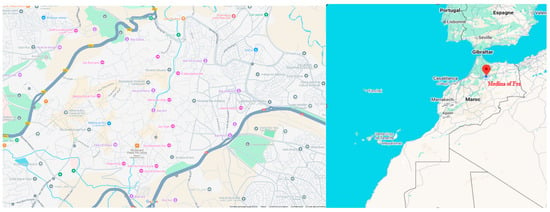
Figure 1.
A view of the heritage entities of the Medina of Fez (screenshot from Google Maps).
Scope: The ontology covers several types of historical entities represented in the Medina of Fez. It includes gardens, squares, derbs, Medina Quarters, and historical buildings.
Historical buildings include the following:
- Religious Buildings: Synagogues, Mosques, and Zawiyas.
- Educational Buildings: Universities and Madrasas.
- Civil Buildings: Palaces, Museums, and Maristans.
- Commercial Buildings: Funduks and Tanneries.
- Urban Infrastructure: Babs and Kasbahs.
The ontology is based on internationally recognized standards for heritage data modeling, reusing classes and properties from CIDOC-CRM, GEOSPARQL, and FOAF ontologies. This combination enables the integration of information about physical entities such as historical buildings, their geographic location, and the people or groups associated with these monuments.
3.2. Specific Classes Used
A Derb (درب) is a narrow alley, often pedestrian, characteristic of the architecture of Moroccan medinas. It provides access to residential areas and may lead to places such as a funduk, a madrasa, or other historical monuments.
A Funduk (فندق) is a traditional historical building found in the medinas of North Africa, historically serving as an inn and warehouse for merchants and caravans. It typically features a central courtyard surrounded by rooms on multiple levels. Some funduks also functioned as commercial and craft centers.
A Madrasa (مدرسة) is a traditional school primarily dedicated to the teaching of Islamic sciences, jurisprudence, and the Arabic language. In the medinas of North Africa, it often served as a boarding school for students and was generally associated with a mosque.
A Zawiya (زاوية) is a religious and spiritual institution in the Islamic world, dedicated to the teaching of Sufism, prayer, and hospitality. It also serves as a place of retreat, religious education, and sometimes houses the tomb of a saint.
A Tannery (دار الدبغ) is a workshop where tanning transforms animal hides into leather. This process takes place in large open-air vats, using natural products to soften and dye the hides, preserving an age-old artisanal craftsmanship.
A Maristan (ماريستان) is a historic hospital in the Islamic world, dedicated to medical and psychiatric care. It also served as a center of learning where knowledge in medicine and pharmacology was transmitted.
A Bab (باب) is a monumental gate marking the entrance to a city, a medina, or a fortified district. In Islamic architecture, it serves both defensive and symbolic functions, acting as a controlled passageway and standing out with its artistic ornaments and inscriptions.
A Kasbah (قصبة) is a fortified citadel typical of the Maghreb, designed both for defense and as a residence for local rulers. Built from rammed earth or stone, it is characterized by its high walls, watchtowers, and often intricate architecture, providing protection and control over the surrounding region.
The Medina Quarter (مدينة عتيقة) is the historic heart of North African cities, renowned for its labyrinthine streets, traditional markets, and rich architectural heritage. Enclosed by walls, it features mosques, funduks, tanneries, and other significant structures, serving as a vibrant cultural and commercial hub.
A square (ساحة) is a public space within the Medina, typically an open area surrounded by historic buildings, souks (traditional markets), or important institutions. It serves as a social gathering place, a hub for commercial exchanges, and occasionally a venue for cultural events.
3.3. Competency Questions
To evaluate the coverage, relevance, and originality of our ontology, we developed a set of 40 competency questions (CQs). These questions are divided into five dimensions that correspond to real information needs regarding monuments, historical buildings, and significant cultural spaces.
Historical Dimension (CQ1–CQ9): This category explores the temporal and historical aspects of the Medina of Fez.
Socio-Cultural Dimension (CQ10–CQ21): This dimension addresses the social role of heritage buildings, their cultural functions, and their connection to local communities. The questions identify founders, social or ritual activities, links to traditional practices, and networks of associated monuments and actors.
Spatial Dimension (CQ22–CQ28): The spatial component evaluates the location and proximity of monuments. It includes questions on geographical coordinates, the spatial clusters of heritage buildings, and the average distances of monuments in the Medina of Fez.
Architectural Dimension (CQ29–CQ35): This category focuses on the physical and stylistic characteristics of the monuments, including building materials, architectural features like domes or courtyards, surface area, and architectural styles.
Heritage Management Dimension (CQ36–CQ40): This final dimension demonstrates the potential utility of the ontology for heritage experts and decision-makers by identifying monuments at risk or partially degraded, restored buildings with their funding sources, monuments listed as part of the World Heritage Site, and monuments that should be prioritized for restoration.
Figure 2 shows a set of questions that the ontology can answer.
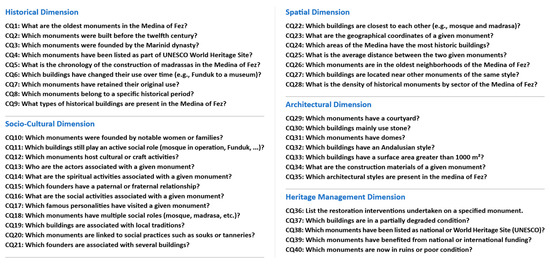
Figure 2.
A set of 40 competency questions.
3.4. Method Adopted
Our study began with an in-depth analysis of the cultural heritage of the Medina of Fez, alongside a review of the CDS to guide the ontological modeling process. We did the mapping between the CDS and the CIDOC standard. Then, we created the Core Ontology, the foundational element for our main ontology. It captures the generic structure of cultural heritage data and offers a reusable framework to integrate the specific features of the Medina of Fez progressively.
The GEOSPARQL ontology and the FOAF ontology were integrated as part of the reuse of existing ontologies. We aligned GEOSPARQL and FOAF with CIDOC.
We added classes specific to the Moroccan context of the Medina of Fez. We defined the hierarchy of classes (by integrating it into our Core Ontology). We determined the object and data properties of the new classes added. We defined the facets of the attributes. We created individuals (Figure 3).
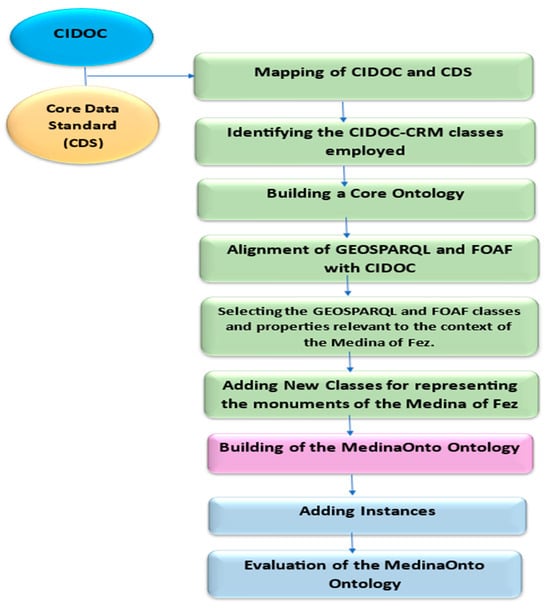
Figure 3.
Diagram of the method adopted.
3.5. The Advantage of This Method
In our work, we initially leveraged the Core Data Standard for its clear and accessible method of organizing and documenting cultural heritage. Even though these sheets are less prevalent today, they provided a solid and proven foundation that has significantly influenced modern heritage management. They allowed us to establish the groundwork for our study. We then built our ontology upon these foundations, integrating CIDOC-CRM, GEOSPARQL, and FOAF to enrich and complement the modeling of Fez Medina’s heritage. These widely used ontologies enable better information integration and sharing. This approach allowed us to combine the structured methodology of the indexing sheets with the flexibility and interoperability of contemporary digital tools, resulting in a framework that is both methodical and innovative.
3.6. Aligning Core Data Standard (CDS) Entities to CIDOC-CRM
The Core Data Standard for Historical Monuments and Architectural Heritage Buildings: Recommendation R(95) 3 of the Committee of Ministers of the Council of Europe to Member States concerning the coordination of methods and systems of documentation for historical monuments and architectural heritage buildings was used [16].
It was established by the Council of Europe and approved by over 100 representatives from 32 countries during the conference titled “Archaeological Heritage: Standards for Inventory and Documentation in Europe” [17].
In this part, we present the data mapping process from the CDS’s Conceptual Data Model [17] (Figure 4) to the classes and properties of the CIDOC-CRM ontology.
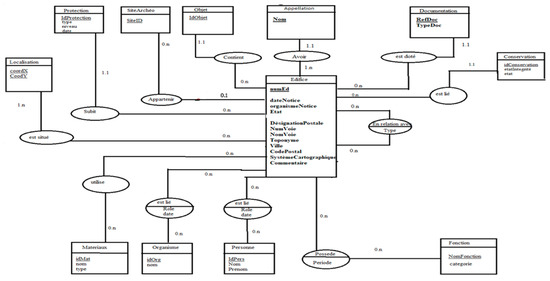
Figure 4.
The Conceptual Data Model of the Core Data Standard.
3.6.1. Mapping of Classes to CIDOC-CRM
This first step is to choose the target CRM classes for mapping. The classes selected from the Core Data Standard’s CDM are shown in Table 1.

Table 1.
Representation of the CDS classes in CIDOC-CRM.
3.6.2. Mapping of Properties to CIDOC-CRM
Some of the CDS properties aligned easily with the CIDOC-CRM, while others required further analysis to establish the mapping. The mappings are presented in Table 2, Table 3, Table 4, Table 5, Table 6, Table 7, Table 8, Table 9, Table 10, Table 11, Table 12 and Table 13.

Table 2.
Representation of the Class Edifice properties (Figure 4) in CIDOC-CRM.

Table 3.
Representation of the Class Appellation properties (Figure 4) in CIDOC-CRM.

Table 4.
Representation of the Class Documentation properties (Figure 4) in CIDOC-CRM.

Table 5.
Representation of the Class Conservation properties (Figure 4) in CIDOC-CRM.

Table 6.
Representation of the Class Fonction properties (Figure 4) in CIDOC-CRM.

Table 7.
Representation of the Class Personne properties (Figure 4) in CIDOC-CRM.

Table 8.
Representation of the Class Organisme properties (Figure 4) in CIDOC-CRM.

Table 9.
Representation of the Class Matériaux properties (Figure 4) in CIDOC-CRM.

Table 10.
Representation of the Class Localisation properties (Figure 4) in CIDOC-CRM.

Table 11.
Representation of the Class Protection properties (Figure 4) in CIDOC-CRM.

Table 12.
Representation of the Class SiteArchéo properties (Figure 4) in CIDOC-CRM.

Table 13.
Representation of the Class Objet properties (Figure 4) in CIDOC-CRM.
According to the mapping, the classes used from CIDOC are as follows: E24_Physical_Human_Made_Thing, E41_Appellation, E52_Time_Span, E31_Document, E55_Type, E53_Place, E94_Space_Primitive, E42_Identifier, E61_Primitive, E39_Actor, E57_Material, E3_Condition_State, E30_Right, E62_String, E27_Site, E59_Primitive_Value, E18_Physical_Thing.
To ensure faithful representation using the CIDOC-CRM classes, we need to introduce additional classes. This will maintain the correct hierarchy between the imported classes and provide a structure consistent with the model. The added classes are as follows: E20_Biological_Object, E19_Physical_Object, E26_Physical_Feature, E22_Human_Made_Object, E25_Human_Made_Feature.
The object properties used from CIDOC-CRM are as follows: P1_is_identified_by, P2_has_type, P3_has_note, P4_has_time_span, P14_carried_out_by, P44_has_condition, P53_has_former_or_current_location, P102_has_title, P168_place_is_defined_by.
3.7. Creating Core Ontology
In developing our ontology, we adopted a two-phase, complementary approach. Initially, we utilized Neo4j5 to design the Core Ontology as a graph. This allowed us to visually model the concepts, their relationships, and the overall structure of the domain (Figure 5).
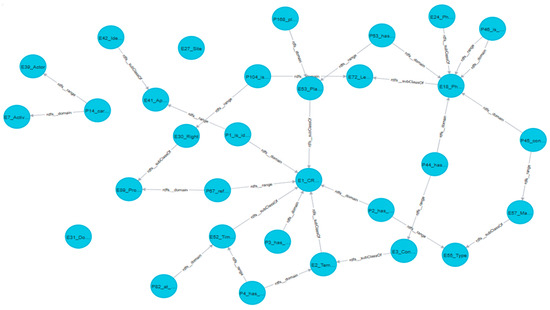
Figure 5.
Classes and Object Properties imported from CIDOC-CRM.
Subsequently, we exported and adapted this base to Protégé, a tool compliant with Semantic Web standards (OWL). This step enabled us to align our ontology with existing ontologies, strengthen semantic consistency, and facilitate interoperability. Finally, we proceeded to create instances within Protégé to enrich the ontology with concrete data and enable the use of reasoning engines. This method allowed us to combine the graphical power of Neo4j with the logical and semantic capabilities of Protégé6.
We used a Cypher Query to import the classes and object properties from CIDOC-CRM to create our Core Ontology:
| MATCH (p:rdf__Property) WHERE p.rdfs__label_en IN [ “P1_is_identified_by”,”P4_has_time_span”, “P67_refers_to”, “P53_has_former_or_current_location”, “P168_place_is_defined_by”, “P2_has_type”, “P82_at_some_time_within”, “P14_carried_out_by”, “P45_consists_of”, “P44_has_condition”, “P104_is_subject_to”, “P3_has_note”, “P46_is_composed_of”] OPTIONAL MATCH (p)-[:rdfs__range]->(rangeClass:rdfs__Class) OPTIONAL MATCH (p)-[:rdfs__domain]->(domainClass:rdfs__Class) WITH p, rangeClass, domainClass MATCH (c1:rdfs__Class) WHERE c1.rdfs__label_en IN [ “E24_Physical_Human_Made_Thing”,”E41_Appellation”,”E52_Time_Span”,”E31_Document”, “E55_Type”, “E53_Place”, “E94_Space_Primitive”, “E42_Identifier”, “E61_Primitive”, “E39_Actor”, “E57_Material”, “E3_Condition_State”, “E30_Right”, “E62_String”, “E2_Temporal_Entity”, “E1_CRM_Entity”, “E89_Propositional_Object”, “E7_Activity”, “E72_Legal_Object”, “E18_Physical_Thing”,”E27_Site”] OPTIONAL MATCH (c1)-[:rdfs__subClassOf]->(c2:rdfs__Class) WHERE c2.rdfs__label_en IN [ “E24_Physical_Human_Made_Thing”,”E41_Appellation”,”E52_Time_Span”,”E31_Document”,”E55_Type”, “E53_Place”, “E94_Space_Primitive”, “E42_Identifier”, “E61_Primitive”, “E39_Actor”, “E57_Material”, “E3_Condition_State”, “E30_Right”, “E62_String”, “E2_Temporal_Entity”, “E1_CRM_Entity”, “E89_Propositional_Object”, “E7_Activity”, “E72_Legal_Object”, “E18_Physical_Thing”, “E27_Site”] RETURN p, rangeClass, domainClass, c1, c2; |
3.8. Aligning GEOSPARQL and FOAF to CIDOC-CRM
3.8.1. Aligning GEOSPARQL to CIDOC-CRM
We performed this alignment by focusing on the classes, objects, and data properties that overlap or complement each other, especially in the context of spatial and geographic information (See Appendix A.1).
3.8.2. Aligning FOAF to CIDOC-CRM
This mapping aims to align social networking concepts from FOAF with cultural heritage concepts from CIDOC-CRM (See Appendix A.2).
3.9. Addition of Specific Classes (with Attributes) for the Historical Entities of the Medina of Fez
Specific classes were added to the existing historical entities in the Medina of Fez, as represented in Figure 6.
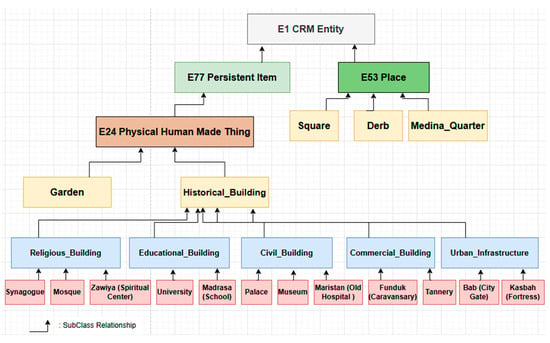
Figure 6.
Specific classes of the Medina of Fez.
For each added class, we specified its object and data properties. Then, we performed the mapping with the classes, object properties, and data properties of CIDOC-CRM.
For example, the Historical_Building Class has the following attributes, as shown in Table 14, and the mapping of these specific attributes to CIDOC-CRM is presented in Table 15.

Table 14.
The Historical_Building Class attributes.

Table 15.
Mapping of the specific attributes of the Historical_Building Class to CIDOC-CRM.
3.10. Building MedinaOnto and Adding Instances
After the creation of the Core Ontology, the alignment of GEOSPARQL and FOAF with CIDOC, and the addition of specific classes, MedinaOnto was built (Figure 7 and Figure 8). Instances from Wikidata and DBpedia were added later (Figure 9).
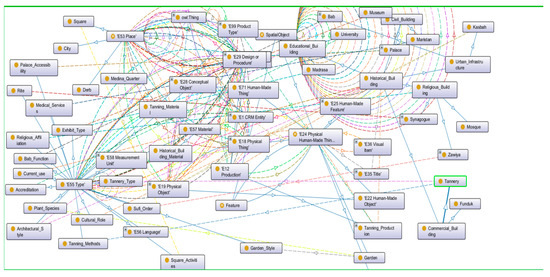
Figure 7.
A visualization of the MedinaOnto classes in Protege 5.5.0.
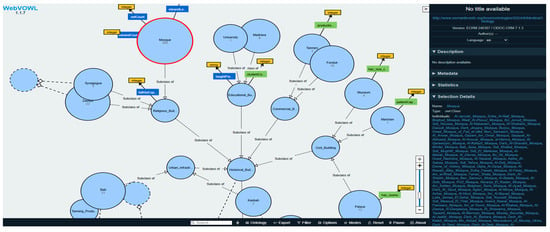
Figure 8.
A visualization of some classes of MedinaOnto in WebVOWL 1.1.7.
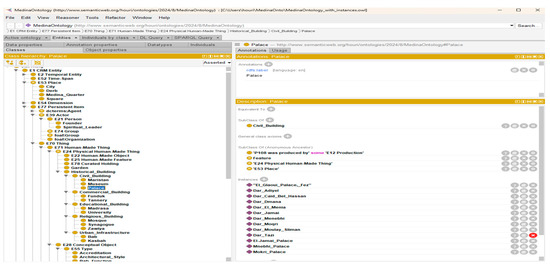
Figure 9.
An overview of MedinaOnto individuals in Protege 5.5.0.
3.11. Implementation
The MedinaOnto ontology was developed using Protégé 5.5.0 as the development environment and OWL as the ontology representation language. It is based on CIDOC CRM version 7.1.3, available on ERLANGEN CRM7. MedinaOnto has 197 classes, 385 object properties, 53 data properties, and 1351 individuals.
4. Evaluation and Discussion
We initiated the validation of the ontology’s logical structure using the HermiT 1.4.3.456 reasoner, which is integrated into the Protégé 5.5.0 environment. This verification confirmed the absence of internal contradictions, both at the class definition and property and hierarchy levels. Automated inference also ensured that subclasses and individual types were correctly propagated within the model, guaranteeing a robust logical foundation. The OntoDebug tool played a complementary role in the local validation of the ontology’s semantic behavior (Figure 10).
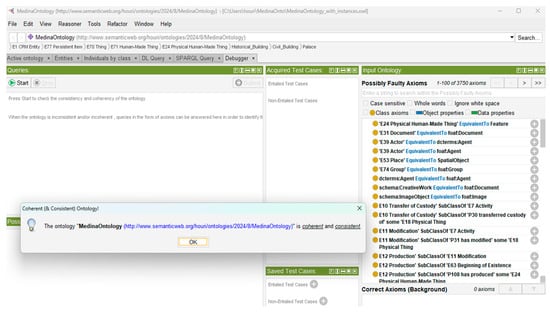
Figure 10.
Checking MedinaOnto’s consistency and coherence with the Protégé’s Debugger (A screenshot from Protégé).
To validate the ontology’s capacity to address the information needs identified during the design phase, a set of 40 Competency Questions (Figure 2) corresponding to five dimensions was tested. The results confirmed that the model supports efficient and relevant querying of heritage data, thereby validating its functional coverage across the historical (an example of a SPARQL query is shown in Figure 11), socio-cultural (an example of a SPARQL query is shown in Figure 12 and Figure 13), spatial (an example of a SPARQL query is shown in Figure 14), architectural spatial (an example of a SPARQL query is shown in Figure 15), and heritage management dimensions (an example of a SPARQL query is shown in Figure 16).
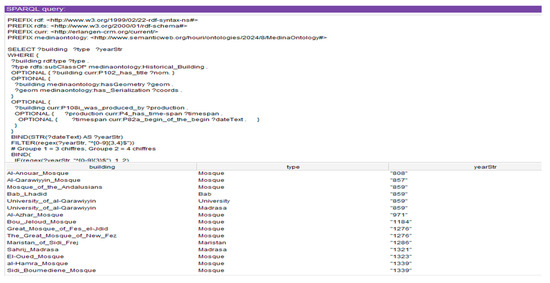
Figure 11.
SPARQL query and its output for CQ1: What are the oldest monuments in the Medina of Fez?
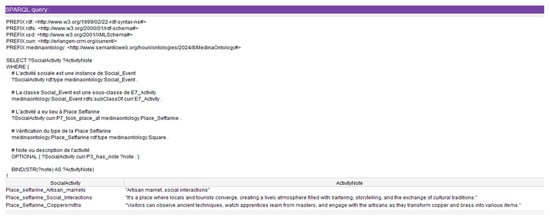
Figure 12.
SPARQL query and its output for CQ16: What are the social activities associated with a given monument?
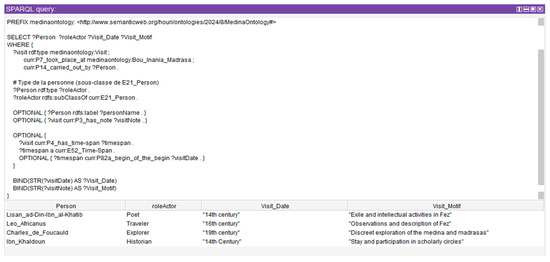
Figure 13.
SPARQL query and its output for CQ17: Which famous personalities have visited a given monument?
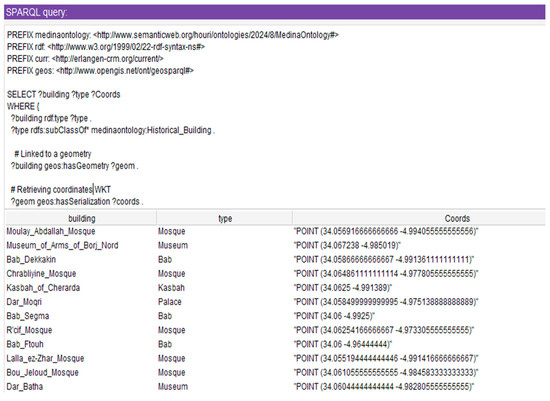
Figure 14.
SPARQL query and its output for CQ22: Which buildings are closest to each other?
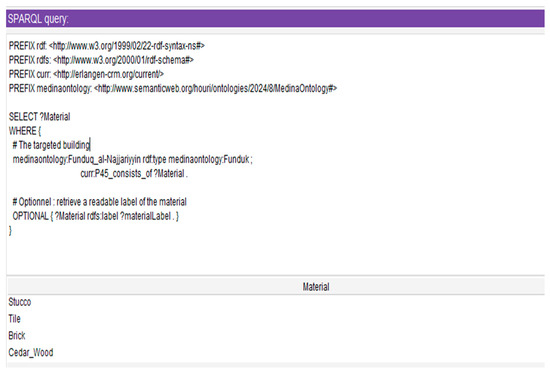
Figure 15.
SPARQL query and its output for CQ34: What are the construction materials of a given monument?
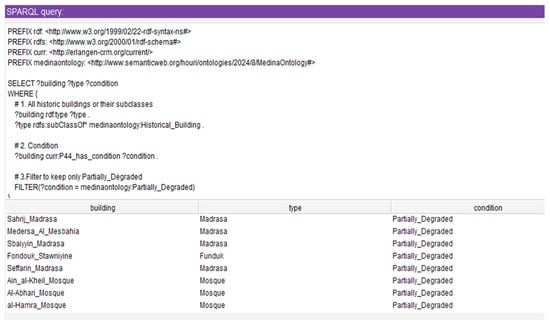
Figure 16.
SPARQL query and its output for CQ37: Which buildings are in a partially degraded condition?
The ontology has been partially aligned with CIDOC-CRM and GEOSPARQL, thereby facilitating interoperability while preserving the specificity of the Medina of Fez’s cultural context.
Additionally, the evaluation was complemented by the development of a web portal (Figure 17) based on MedinaOnto. This portal was developed to demonstrate the practical utility of the MedinaOnto ontology for both the public and heritage professionals:
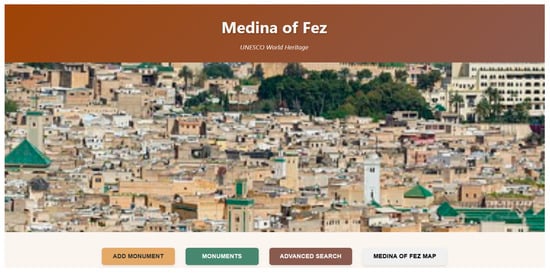
Figure 17.
Medina of Fez Web Portal.
Tourist and public access: It provides an interactive map (Figure 18) and detailed information on the monuments of the Medina of Fez (Figure 19 provides an example of the information available for Dar Batha Museum), allowing users to explore its cultural richness.
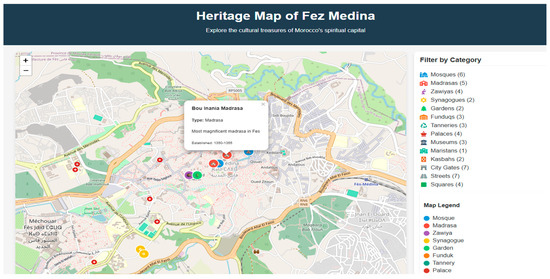
Figure 18.
Medina of Fez Heritage Map.
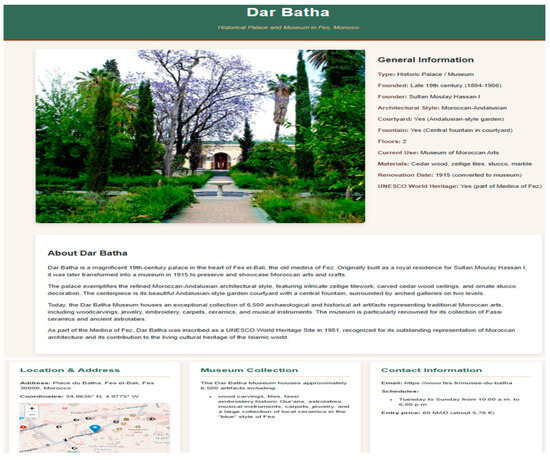
Figure 19.
The information available for Dar Batha (Museum).
Heritage professional access: It enables experts to consult data on the cultural value and condition state of monuments, as well as to add or modify monument entries (Figure 20 presents the form that heritage experts use to input information for a new monument), thus contributing to the continuous enrichment of the Medina of Fez knowledge graph.
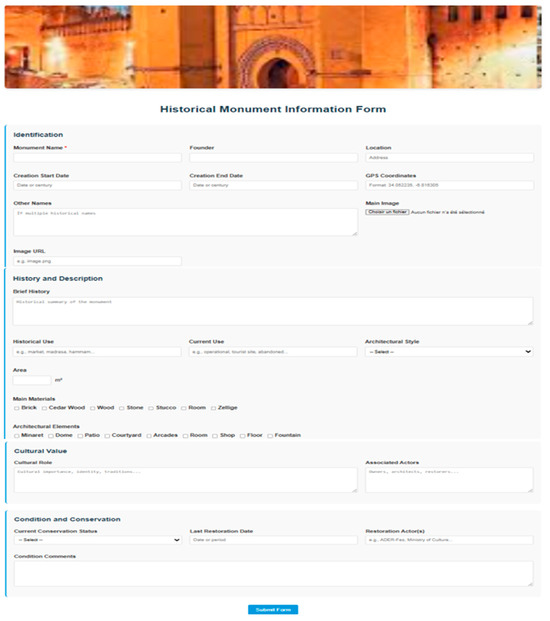
Figure 20.
A form that heritage experts use to input information for a new monument.
The evaluation of MedinaOnto confirms that the ontology effectively addresses the research objectives. It provides a coherent and extensible model of the Medina of Fez, integrating historical, spatial, architectural, socio-cultural, and heritage management perspectives (RQ1). Its alignment with CIDOC-CRM, GEOSPARQL, and FOAF ensures semantic interoperability and explicit representation of heritage values (RQ2). Furthermore, the interactive portal demonstrates the ontology’s practical utility: it supports heritage professionals in decision-making regarding monument preservation and valorization, while enhancing cultural mediation for tourists and the public (RQ3).
5. Conclusions and Future Work
This work presented MedinaOnto, a coherent and extensible ontology designed to model the built heritage of the Medina of Fez, integrating historical, spatial, architectural, socio-cultural, and heritage management dimensions. By aligning the ontology with CIDOC-CRM, GEOSPARQL, and FOAF, we ensured semantic interoperability and the explicit representation of heritage values, enabling the generation of rich knowledge graphs of the Medina of Fez.
The evaluation demonstrated that MedinaOnto effectively answers a wide range of competency questions across five dimensions. Moreover, the interactive portal developed on top of MedinaOnto illustrates its practical utility:
For heritage professionals, it facilitates rapid access to essential information on monument conditions and cultural significance, supports preservation and restoration decisions, and enables the enrichment of the knowledge graph through the addition or update of monuments.
For tourists and the public, it provides an interactive exploration of the Medina’s monuments, enhancing cultural mediation and promoting heritage awareness.
Despite these contributions, several avenues for future work remain:
Ontology Enrichment and Alignment: This involves extending MedinaOnto to include intangible heritage and urban evolution data, while deepening alignment with other linked open data sources.
Reasoning and Inference: This includes integrating semantic reasoning to automatically detect at-risk monuments, suggesting restoration priorities, or inferring historical relationships between buildings and actors.
User-Centered and Collaborative Features: This would enhance the portal to allow crowdsourced contributions from local communities and collaborative workflows for heritage experts.
In conclusion, MedinaOnto lays a solid foundation for a semantic, interoperable, and actionable knowledge base for the preservation, valorization, and dissemination of the Medina of Fez heritage, paving the way for sustainable digital heritage management and smart cultural tourism applications.
Author Contributions
Conceptualization, H.D.; Methodology, H.D., I.C., and A.Z.; Formal analysis, H.D.; Writing—original draft preparation, H.D.; Writing—review and editing, H.D., I.C., and A.Z.; Supervision, I.C., and A.Z. All authors have read and agreed to the published version of the manuscript.
Funding
This research received no external funding.
Data Availability Statement
The data presented in this study are available upon reasonable request.
Conflicts of Interest
The authors declare no conflicts of interest.
Appendix A
Appendix A.1

Table A1.
Mapping the GEOSPARQL Classes to CIDOC-CRM.
Table A1.
Mapping the GEOSPARQL Classes to CIDOC-CRM.
| GEOSPARQL Class | CIDOC-CRM Class | Notes |
|---|---|---|
| geo: SpatialObject | E53_Place | E53_Place includes both physical and abstract spaces. |
| geo: Feature | E24_Physical_Human_Made_Thing | geo: Feature represents a spatial feature that corresponds to buildings or objects in CIDOC. |
| geo: Geometry | E94_Space_Primitive (abstract primitive) | geo: Geometry describes the geometry of spatial objects, and E94_Space_Primitive can represent specific locations. |

Table A2.
Mapping the GEOSPARQL Object Properties to CIDOC-CRM.
Table A2.
Mapping the GEOSPARQL Object Properties to CIDOC-CRM.
| GEOSPARQL Class | CIDOC-CRM Class | Notes |
|---|---|---|
| geo:hasGeometry | P168_place_is_defined_by (Data property) | Geometry or coordinates of a place. |
| geo:ehContains | P89i_contains | Spatial containment. |
| geo:ehOverlap | P121_overlaps_with | Spatial intersection between objects or places. |
| geo:ehCoveredBy | P89_falls_within | Geographic space is contained within another. |
| geo:ehCovers | P89i_contains | Geographic space contains another. |
| geo:ehInside | P89_falls_within | Geographic space is within another. |
| geo:ehMeet | P122_borders_with | Geographical areas meet at their borders. |
Appendix A.2

Table A3.
Mapping the FOAF Classes to CIDOC-CRM.
Table A3.
Mapping the FOAF Classes to CIDOC-CRM.
| FOAF Class | CIDOC-CRM Class | Notes |
|---|---|---|
| foaf:Agent | E39_Actor | Person or group. |
| foaf:Person | E21_Person | A person. |
| foaf:Organization | E74_Group | FOAF targets formal structures; CIDOC includes all groups. |
| foaf:Group | E74_Group | FOAF is less specific about group nature. |
| foaf:Project | E7_Activity/E5_Event | FOAF refers to projects, CIDOC to general actions or events. |
| foaf:Document | E31_Document | Physical or digital document. |
| foaf:Image | E73_Information_Object | CIDOC is more generic. |
| foaf:OnlineAccount | E73_Information_Object | No direct match; CIDOC use is approximate. |
| foaf:PersonalProfileDocument | E31_Document | CIDOC is more generic. |
| foaf:Collection | E78_Curated_Holding | FOAF: unstructured set; CIDOC: curated collection. |

Table A4.
Mapping the FOAF Object Properties to CIDOC-CRM.
Table A4.
Mapping the FOAF Object Properties to CIDOC-CRM.
| FOAF Class | CIDOC-CRM Class | Notes |
|---|---|---|
| foaf:knows | No direct equivalent | It can be modeled through social events or shared activities. |
| foaf:member | P107_has_current_or_former_member | Links a group to its members. |
| foaf:made | P94_has_created | Links a creator to the created object. |
| foaf:maker | P94i_was_created_by | Inverse of P94; from object to its creator. |
| foaf:depiction | P138_represents | CIDOC is more generic. |
| foaf:img | P138_represents | foaf:img is like foaf:depiction. |
| foaf:topic | P129_is_about | Links a resource to its subject. |
| foaf:fundedBy | No direct equivalent (P14_carried_out_by with E39_Actor in the role of funder). | Requires modeling funding as an activity with roles. |

Table A5.
Mapping the FOAF Data Properties to CIDOC-CRM.
Table A5.
Mapping the FOAF Data Properties to CIDOC-CRM.
| FOAF Class | CIDOC-CRM Class | Notes |
|---|---|---|
| foaf:firstName | P1_is_identified_by | CIDOC is more generic. |
| foaf:familyName | P1_is_identified_by | CIDOC is more generic. |
| foaf:surname | P1_is_identified_by | CIDOC requires specifying the appellation type. |
| foaf:lastName | P1_is_identified_by | CIDOC does not separate first/last names by default. |
| foaf:gender | P2_has_type | FOAF has a direct literal value; CIDOC uses a type class (E55_Type). |
| foaf:age | P1_is_identified_by (approx.) | No direct match; may require custom modeling with time-span properties. |
| foaf:birthday | P98i_was_born | FOAF uses a literal date; CIDOC models birth as an event linked to a person. |
Notes
| 1 | https://cidoc-crm.org (accessed on 9 March 2025). |
| 2 | https://www.ogc.org/standards/geosparql (accessed on 9 March 2025). |
| 3 | http://xmlns.com/foaf/spec (accessed on 9 March 2025). |
| 4 | https://rm.coe.int/09000016804d6b13 (accessed on 24 January 2025). |
| 5 | https://neo4j.com (accessed on 9 March 2025). |
| 6 | https://protege.stanford.edu (accessed on 9 March 2025). |
| 7 | http://erlangen-crm.org/ (accessed on 9 March 2025). |
References
- UNESCO World Heritage Convention. Medina of Fez. Available online: https://whc.unesco.org/fr/list/170 (accessed on 7 January 2025).
- Daoudi, H.; Chaker, I.; Zahi, A. Comparative Study of Cultural Heritage Ontologies. In Proceedings of the 2023 IEEE International Conference on Technology Management, Operations and Decisions, ICTMOD, Rabat, Morocco, 22–24 November 2023. [Google Scholar] [CrossRef]
- Krabina, B. Building a Knowledge Graph for the History of Vienna with Semantic MediaWiki. J. Web Semant. 2023, 76, 100771. [Google Scholar] [CrossRef]
- Almeida, B.; Costa, R. OntoAndalus: An ontology of Islamic artefacts for terminological purposes. Semant. Web 2021, 12, 295–311. [Google Scholar] [CrossRef]
- Diarra, D.; Clouzot, M.; Nicolle, C. Mediev’Enl—A domain ontology for cultural heritage items: Case of medieval illuminations of Burgundy duke. Rev. Afr. Rech. Inform. Math. Appliquées 2025, 43, 1–18. [Google Scholar] [CrossRef]
- Pinto, A.; Cardinale, Y.; Dongo, I.; Ticona-Herrera, R. An Ontology for Modeling Cultural Heritage Knowledge in Urban Tourism. IEEE Access 2022, 10, 61820–61842. [Google Scholar] [CrossRef]
- Nafis, F.; Aghoutane, B.; Yahyaouy, A. Semantic integration of Moroccan Cultural Heritage using CIDOC-CRM: Case of Drâa-Tafilalet zone. Int. J. Cloud Comput. 2021, 10, 548–564. [Google Scholar] [CrossRef]
- Cheng, Y.-M.; Kuo, C.-L.; Mou, C.-C. Ontology-Based HBIM for Historic Buildings with Traditional Woodwork in Taiwan. J. Civ. Eng. Manag. 2021, 27, 27–44. [Google Scholar] [CrossRef]
- Marín-Miranda, M.J.; Fra Paleo, U.; Redweik, P.; Gómez-Gutiérrez, Á. An ontology to describe the damage process to build cultural heritage triggered by earthquakes: The CHEDO model. J. Cult. Herit. 2025, 71, 114–126. [Google Scholar] [CrossRef]
- Heesom, D.; Boden, P.; Hatfield, A.; Rooble, S.; Andrews, K. Developing a collaborative HBIM to integrate tangible and intangible cultural heritage. Int. J. Build. Pathol. Adapt. 2021, 39, 72–95. [Google Scholar] [CrossRef]
- Baik, A.; Yaagoubi, R.; Boehm, J. Integration of jeddah historical bim and 3D GIS for documentation and restoration of historical monument. Int. Arch. Photogramm. Remote Sens. Spat. Inf. Sci. 2015, XL-5/W7, 29–34. [Google Scholar] [CrossRef]
- Nieto-Julián, E.; Robador, M.; Moyano, J.; Bruno, S. Semantic HBIM for Heritage Conservation: A Methodology for Mapping Deterioration and Structural Deformation in Historic Envelopes. Buildings 2025, 15, 1990. [Google Scholar] [CrossRef]
- Oliveira, D.; Guerra, S.; Tibaut, A.; Babič, N. The Ontologization of Conservation and Rehabilitation Interventions in Heritage Buildings. In Knowledge Transfer in the Sustainable Rehabilitation and Risk Management of the Built Environment; Springer Series in Geomechanics and Geoengineering; Springer: Cham, Switzerland, 2024. [Google Scholar] [CrossRef]
- Messaoudi, T.; Véron, P.; Halin, G.; De Luca, L. An ontological model for the reality-based 3D annotation of heritage building conservation state. J. Cult. Herit. 2018, 29, 100–112. [Google Scholar] [CrossRef]
- Hyvönen, E. Publishing and Using Cultural Heritage Linked Data on the Semantic Web; Synthesis Lectures on the Semantic Web: Theory and Technology; Springer: Cham, Switzerland, 2012. [Google Scholar] [CrossRef]
- Service de l’Inventaire du Patrimoine Culturel. Available online: https://bibliotheque-patrimoine.bretagne.bzh/Record.htm?idlist=1&record=19109973124919271559 (accessed on 24 January 2025).
- Fiche D’indexation Minimale Pour les Sites Pour les Sites Archéologiques (1999). Available online: https://book.coe.int/fr/patrimoine-culturel/1743-fiche-d-indexation-minimale-pour-les-sites-archeologiques.html (accessed on 24 January 2025).
Disclaimer/Publisher’s Note: The statements, opinions and data contained in all publications are solely those of the individual author(s) and contributor(s) and not of MDPI and/or the editor(s). MDPI and/or the editor(s) disclaim responsibility for any injury to people or property resulting from any ideas, methods, instructions or products referred to in the content. |
© 2025 by the authors. Licensee MDPI, Basel, Switzerland. This article is an open access article distributed under the terms and conditions of the Creative Commons Attribution (CC BY) license (https://creativecommons.org/licenses/by/4.0/).